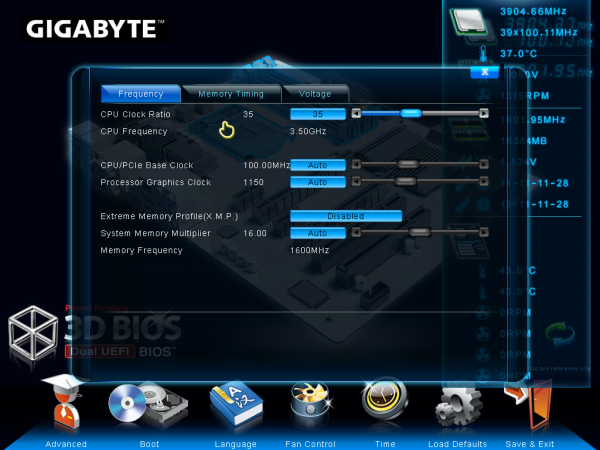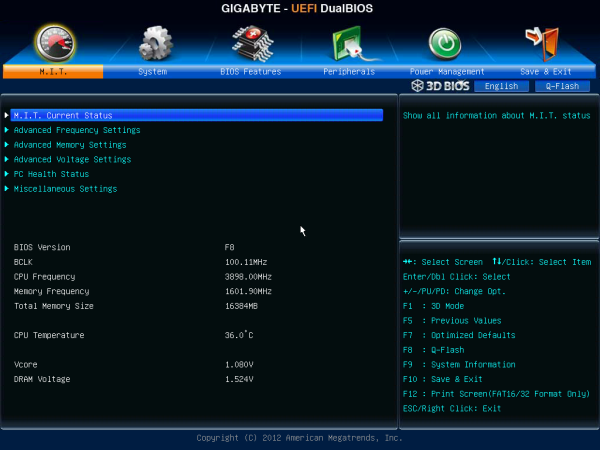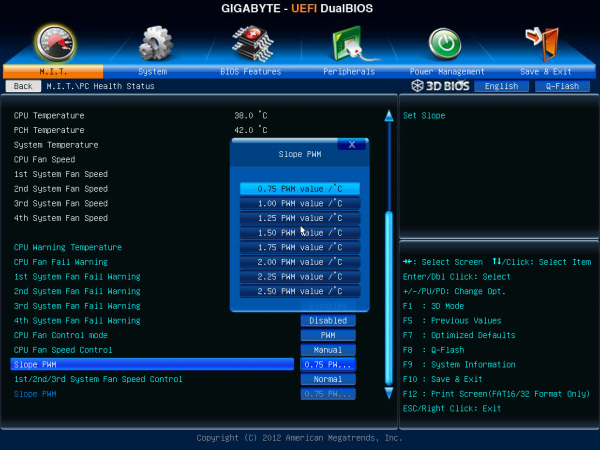Gigabyte GA-Z77X-UD5H Review: Functionality meets Competitive Pricing
by Ian Cutress on July 25, 2012 5:00 AM EST- Posted in
- Motherboards
- Gigabyte
- Z77
Gigabyte GA-Z77X-UD5H BIOS
As of late, I have been critical of the Gigabyte BIOS system. Their 3D BIOS implementation of a graphical UEFI used to be very slow to respond, and as a result made it a pig to navigate. Fast forward on a generation and our 3D BIOS is super fast, highly responsive, and more of a pleasure to use. The 3D BIOS philosophy is a little odd, as the only thing 3D about the BIOS screen is the perspective - it is still a 2D image but at an oblique angle.
The front screen of the Gigabyte BIOS uses this oblique image to act as a clickable interface for different parts of the motherboard. Users can select the CPU, the memory, the rear IO, the PCIe, the SATA connectors or the chipset in order to bring up a separate menu containing several advanced options for that area of the motherboard. This unfortunately falls down on a few areas:
Should a non-enthusiast user have this system as part of a pre-built computer (for example, my parents) and need to enter the BIOS, they will not know what to click as they do not understand what a motherboard is. I would not be able to explain 'click the SATA ports' as they do not know what SATA ports are. What we could do with here is some hover text over each part to explain what each part is in non-technical language.
In addition, as an enthusiast, my main priority of a BIOS is to manipulate and diagnose. The first screen I should see should have all the important information on it - the motherboard I am using, the CPU installed, the speed of the CPU (voltages and temperatures would be handy), the memory size, the memory speed, and other relevant data (boot sequence, hard drives). With a screen like 3D BIOS, some of this information is available straight away, and some is provided when the oblique image is clicked (see image below) but is covered by the menu brought up. For the real information, I will need to navigate through separate menus. There is enough leeway with a UEFI to be able to cater to both the enthusiast and the non-technical; it is just a shame that motherboard manufacturers still cannot get it right.
In the advanced menu, the first screen we come to is the M.I.T (Motherboard Intelligent Tweaker?). This has some valid information to greet us - BIOS version, CPU speed and voltage, memory size, frequency and voltage, and CPU temperature. The 'Current Status' option provides a longer list of exact settings, helpful for diagnosis.
Overclock options are found throughout several menus: CPU clocks and ratios are adjusted in "Advanced Frequency Settings"; memory timings and straps can be changed in "Advanced Memory Settings"; and anything relating to voltages or the 3D Power delivery options are found in "Voltage Settings". It does confuse me a little, as motherboard manufacturers have this overwhelming tendency to put options in one place only. The BIOS should be a tool that is easy to use, so why not put the voltage options for the CPU in with the CPU clocks and ratios? Or 3D Power options related to a CPU in a sub-menu in the Frequency options? The only motherboard manufacturer who is not using what is essentially a basic text and option interface right now is Intel on their own motherboards, so it does strike me as strange that no-one else is doing it.
Fan options in the BIOS are found in the M.I.T. -> PC Health Status menu, located at the bottom. Gigabyte fan controls are limited at best, especially when you compare them to the best in the motherboard arena - users here have to try to understand the options provided. The units PWM value / ºC mean nothing to everyone. Some sort of system needs to be devised here which users can input temperatures when they want the fans to idle and when they want the fans to be at 100%, and the BIOS calculates the appropriate 'PWM value/ºC' to select.
Despite my critical analysis of the Gigabyte BIOS, I found it easy to navigate by the arrow keys (my preferred method) and type in values during overclocking. It is a big step up from the first iterations of Gigabyte's 3D BIOS for sure.




















70 Comments
View All Comments
jardows2 - Wednesday, July 25, 2012 - link
Can anyone explain the value in multiple Ethernet ports? Outside of being server board, and some specialized workstations, the practicality (and added cost) of multiple Ethernet ports escapes me.IanCutress - Wednesday, July 25, 2012 - link
Connecting to multiple networks, redundancy, teaming for better throughput, connecting via ICS, VM throughput, one specifically for backups, separation of traffic (i.e. you could have a combo web/database server, same network, put all web traffic on one NIC, db traffic on the other, makes it easier to calculate loads for traffic types). If you're streaming from a NAS that supports teaming, then the improved bandwidth can benefit users that stream from that device. Agreed, it is a perhaps a niche scenario, but there are enough users that want it. The Realtek NIC + Audio is a relatively cheap bundle, but some people prefer the Intel NIC. So why not have both, as long as the price for the user is reasonable.Ian
Snotling - Wednesday, July 25, 2012 - link
If your NAS has two ports... you can team up your nick on both ends.If your two NICs have different chip-sets then it may be for compatibility reasons. Some businesses will want to use only the Broadcom or only the Intel or Marvel... etc. Maybe at some point you can save downtime if a driver update causes a problem either by being bugged or missing.
Load balancing, bridging networks, Acting as gateway or firewall... even if you do not actually run a server on the board you may want to do it for test purposes or some weird networking condition. Like having two different VPNs that require you to be on two different subnets.
I admit, most of this is exceptional conditions but the exceptions addup and higher end boards aim to cover the needs of those who may run into those situations or actually need them.
Grok42 - Wednesday, July 25, 2012 - link
I can't figure it out either. I've built boxes with many nics before for routers, gateways and bridges. Almost all the servers I've built have had 4 nics. However, I can't imagine using the two nics on this board for anything. Why would I want to build a NAS box with SLI and overclocking? Why wouldn't I get a much different board and add a good discrete NIC board with multiple ports? At the consumer level I can't imagine doing any of this. My file server only has a single gigabit nic and is WAY faster that I need. I can move GBs of files in just a few seconds between it and my workstations. At work we have 10GB and we team ports to increase even that so I know there are needs for higher speeds, I just can't figure out a reason at the consumer level this board is obviously focused on.Einy0 - Wednesday, July 25, 2012 - link
I own this board, it is amazing thus far. I haven't really had a chance to really push it too hard yet... One of these weekends I will try some overclocking. The 3770K is so fast, I'm still getting used to it. I am really impressed with the Z77's SATA controllers. My Vertex 4 is topping out at about 562MB/s for reads and my 4 disk (500GB WD Blue) RAID5 Array is hitting around 362MB/s for reads. I would love one more USB 2.0 header or a USB 3.0 to 2.0 header adapter. A non Realtek audio codec would be terrific too...vailr - Wednesday, July 25, 2012 - link
There's evidently 2 board versions of the UD5H:The older version has a space in between the 2nd & 3rd DDR3 slots, with blue capacitors.
The newer version has no space in between the 2nd & 3rd DDR3 slots, with purple capacitors.
Question: why doesn't Gigabyte provide drivers for the VIA USB 3.0 ports? There are some VIA USB 3.0 drivers on www.station-drivers.com, but those fail to install on Windows 7 64-bit.
Sabresiberian - Thursday, July 26, 2012 - link
One of Gigabyte's strengths is that they've long had dual Ethernet capability, but -Why only one Intel? Is it really that much more expensive to just put the best in here?
I think your read of Gigabyte has been right on the money Ian, I've long thought the same, and wondered why some media types blew their horn so loudly.
;)
Zak - Saturday, July 28, 2012 - link
I see no point in adding FireWire any more... I'd rather have two eSATA ports or another SPDIF output. Any why having DVI, DP and VGA? Waste of space. I really doubt anyone has a need for all three simultaneously. If someone needs to use VGA they can use DVI or DP adapter.Zak - Saturday, July 28, 2012 - link
Typo: "Overclocking on the UD5H was a mixed back of results"JimDicks - Saturday, July 28, 2012 - link
This GB mainboard comes with a Marvell 9172 6Gbit/s S-ATA controller, almost same as my GB mainboard. When I recently bought a 6Gbit/s SSD and connected it to the 'superb' Marvell, it only reached about 250MB/s instead of the advertised 600MB/s. A whole afternoon searching and reading forums and specifications revealed that most of these 3rd party chips have a higher latency than the Intel/AMD south bridges, and reach much lower data rate than advertised, because they are connected via 1, maximum 2 PCIe 2.0 lanes to the mainboard. That means that a controller with 4 6.0Gbit/s connectors would need 2.4GB/s to transfer, yet it can only theoretically transfer 0.5GB/s (1 lane) or 1.0GB/s (2 PCIe 2.0 lanes) to the mainboard. In fact, the practical PCIe speed is much less.I recommend that Anandtech not only checks USB speeds, but also S-ATA speeds via the 3rd party chips, the southbridge and via external PCIe x8 SAS Raid Controller (ie. LSI MegaRAID SAS 9240 or 9260). The latter could also be used to check the practical PCIe bandwiths.